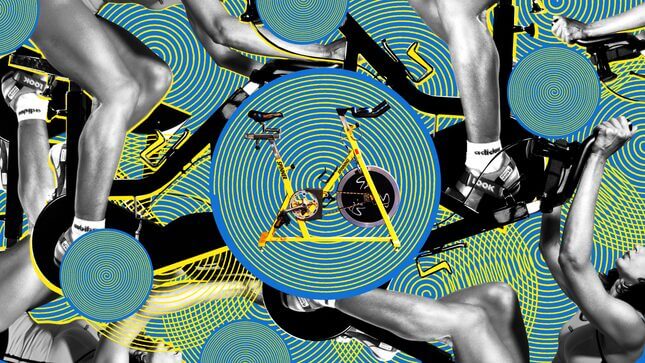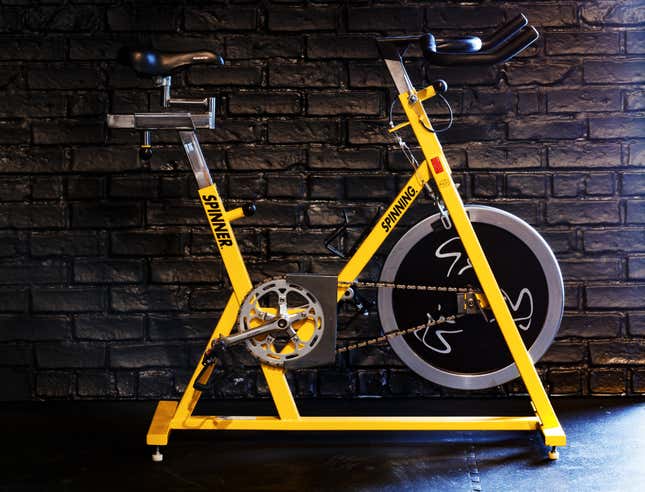Before Peloton There Was Spinning®: How 2 Guys Named John Birthed the Unwieldy Fitness Trend
In DepthIn Depth
Image: Elena Scotti (Photos: Getty Images)
In 2014, FiveThirtyEight published a story by Mona Chalabi titled “Why Women Don’t Cycle,” examining studies that attempted to answer the baffling question of why a gender gap exists among outdoor cycling enthusiasts. The article found a number of wide-ranging answers, including cost, safety, fashion, and convenience. Women didn’t cycle outdoors because they could be attacked or because bikes couldn’t haul both children and groceries. Bikes are expensive and, as the article so eloquently states, “women earn less than men.” This gap has closed somewhat—according to a report from fitness tracking app Strava, more women are biking outside during the pandemic. But though women may not have been biking in the streets, they were cycling their hearts out en masse indoors at studios like SoulCycle or FlyWheel.
Walk into any cycling studio today and more likely than not the instructor, front desk attendant, and cyclist next to you is a woman. While outdoor cycling may have been seen as a male-dominated sport, in the last decade, indoor cycling has become the domain of women, a stronghold that has transcended exercise trends and is now situated in something akin to women’s lifestyle. But that wasn’t yet the case in 1991 when two guys, coincidentally both named John, opened their first commercial cycling studio in Los Angeles and started what would be one of the longest-running trends to come out of the ’90s.
In the last decade, indoor cycling has become the domain of women
Before there was a multibillion-dollar indoor cycling industry with every kind of theme class one can imagine, there was Spinning. Spinning—the exercise method, the most replicated style of bike, and the specific pedagogy—was created in 1991, during a partnership between elite cyclist Johnny Goldberg and entrepreneur John Baudhuin.
Goldberg birthed the modern-day style of cycling almost by accident. In 1989, he was training for the Race Across America. But his wife was pregnant, and as a compromise to keep him home more, Goldberg rigged one of his bikes to be stationary so he could maintain his training without leaving his kitchen. That one kitchen bike attracted Goldberg’s fellow riders, who started taking turns testing out Goldberg’s new rig. The visits became so frequent that he eventually opened up a tiny studio to help more cyclists train at once and get all of them out of his kitchen.
The two Johns met serendipitously in California after Goldberg had opened his first studio in Santa Monica. Baudhuin was working full time and going for his MBA and came up against a common foe of fitness enthusiasts: there just wasn’t enough time to train. “It was really difficult to fit in workouts, especially if you want to go out on the road in LA,” he told Jezebel in a call. “It was always a time constraint.”
He first met Goldberg at his studio, where he was working to train other elite cyclists by teaching classes in a room filled with stationary bikes. “Johnny was a trainer and a coach,” Baudhuin says, “but he was also training for the race across America.” To train for the grueling ride, “you really need to spend probably no fewer than eight hours a day on the bike” However, the bikes that Goldberg was using for training, which Baudhuin described as “basically just bikes,” and didn’t “work out for what the exercise was.”
While the Johns’ Spinning classes are largely responsible for the current cult status of indoor cycling, the exercise itself is quite old. The first stationary bike, the Gymnasticon, was invented in 1796. It was an enormous contraption that required the rider to sit upright in order to move two huge wheels using both the arms and the legs. The stationary bikes of the late ’80s, designed for the casual at-home user and weren’t made to accommodate high-speeds and copious pedaling that the Johns needed to properly train for road cycling year-round. Some bikes featured handles that moved, similar to the modern-day assault bikes found in CrossFits and gym franchises the world over. But the Johns needed a bike that would allow students to simulate changing road terrain and stable enough to not shake or tip when riders increased their speed. So they started building bikes in their respective garages, and in 1992 the first Spinner bike was born.

The design of the original Spinner serves as the blueprint for bikes used in classes today. The weighted front wheel (known as a flywheel), the shape of the handlebars, and the compact frame solved the problems of bringing an outdoor workout into the home. The flywheel, arguably the most important component on any stationary bike, limits the wheel’s rotation and allows for heavy resistance. Even the bright yellow color feels incredibly familiar to anyone who’s ridden on a SoulCycle bike circa 2006.
-

-

-

-

-

-

-

-

-

-

-

-

-

-

-

-

-

-

-

-

-

-

-

-

-

-

-

-

-

-

-

-

-

-

-

-

-

-

-

-








































